The festivities dedicated around the Day of the Dead in Mexico are one of the most recognized annual Mexican celebrations in the world, not only thanks to the James Bond movie “Specter” or Disney’s “Coco” but also for being named Intangible Heritage of Humanity by UNESCO in 2008 and for its graphic recurrence in the world-famous works of Frida Kahlo and Diego Rivera.
It is a colorful celebration, and it concerns everyone since, sooner or later, in one way or another, it is part of our lives, as the streaming series “Das letzte Wort” reminds us.
Each religion has a different ritual around the deceased and each culture has placed its symbolic charge on it over time.
Speaking about death
Death, whether or not it is spoken of, is a natural and human phenomenon, it is a ritual and a transformation. It is a pretext or source of inspiration to create art: poems and paintings.
Death is a reminder of our finitude in the earthly world tells us the Tlatoani Nezahualcóyotl (1402-1492) Do you come to live only once on earth? in which he expresses in the final part of one of his songs that we find in the “Romances de los Señores de la Nueva España” fol.22v:
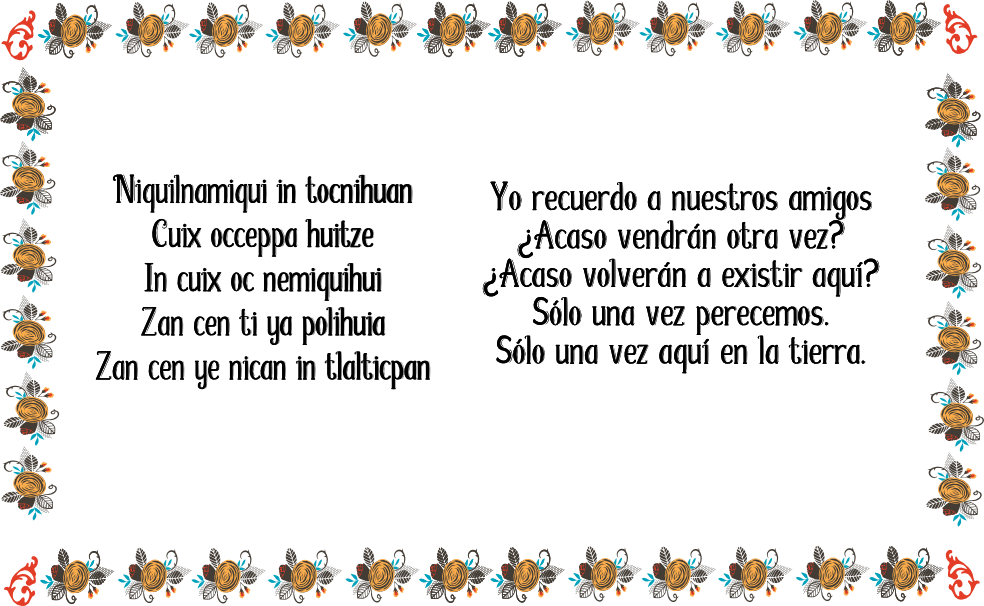
In Christian and Western thoughts, life and death are an antagonism, time is linear, therefore life excludes death. We can read various sources such as the Bible or Dante Alighieri’s Divine Comedy to give us an idea of the concept of death.
In Mesoamerican and Nahuatl thoughts to live is not only to exist or walk but also to die and gives a sense of recurrence to time itself.
The buried corpses are living with mother earth, being their food, and the souls are living in one of the houses of the gods, depending on the age and way in which they have stopped living on earth, these are: Mictlan ( place of the dead), Tlalocan (house of Tlaloc), Tonatiuh ichan (house of the sun), and the abode of Huitzilopochtli.
We can read more on the subject in the works of my teacher Patrick Johansson, or in the sources or Relations of the friars such as the General History of the Things of New Spain by Fray Bernardino de Sahagún.
The festivities
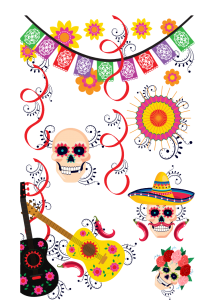
The festivities for the dead do not only come from the Christian celebration of All Saints’ Day, 1st. November, and faithful departed, November 2, in which the cemetery is visited, flowers are taken, graves are cleaned and a religious service is held.
They also come from a pre-Hispanic Nahua celebration to the god Mictlantecuhtli, in which offerings were offered.
I do not want to leave aside that around these dates there is a change of seasons in the agrarian calendar.
Therefore it gives rise to other types of celebrations with very different origins and purposes such as the Celtic festival known as Samhain which means “end of summer “. Subsequently, it gave rise to the world-famous Halloween today.
The Day of the Dead
In Mexico, the Day of the Dead is a syncretic celebration, in which rituals are performed and offerings are made, altars are placed and meetings are held in cemeteries, people eat, drink, sing. Each region has its respective particularity, but it is prayed in all of them.
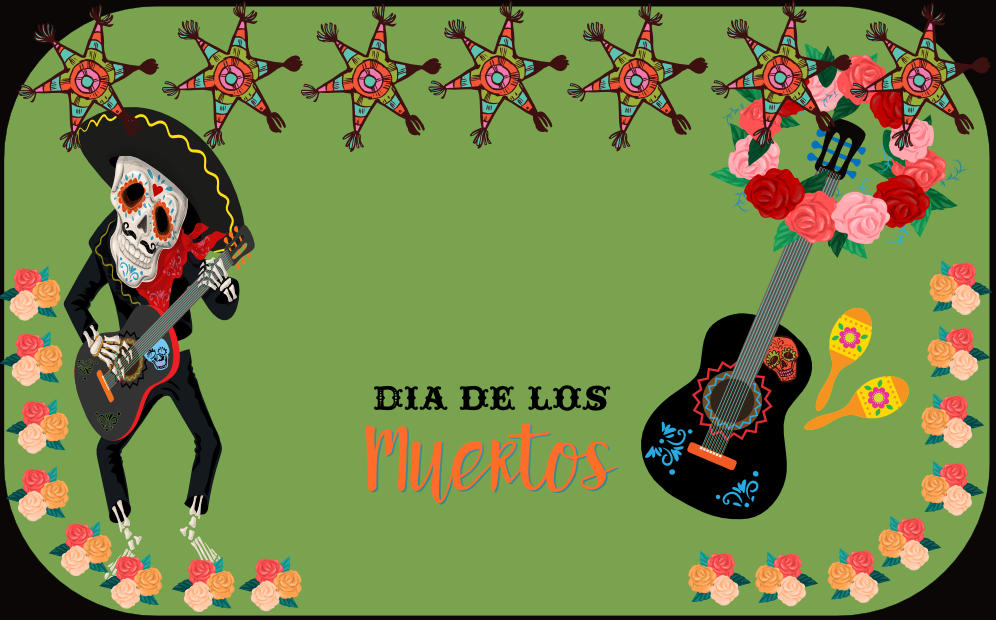
The places with the most tourist influx are: the lake region of Pátzcuaro, Michoacán; the Mixquic neighborhood in Mexico City; the Xantolo party (feast of souls) in the Huasteca region of San Luis Potosí, the feast of the Huehuentones (returning old men) in Huautla de Jiménez, Oaxaca; and in the Mayan zone, in the city of Pomuch, Campeche.
Thanks to all this we can see that the celebration of death in Mexico is a motive, for a fusion, for a coexistence of ideological systems and therefore for a cultural amalgam that gives rise beyond a process of acculturation, to a form identification.
What does this celebration consist of?
What does this celebration consist of? It is thought that at the end of October to be precise from October 28 to November 3, the souls come down to earth to live with the living.
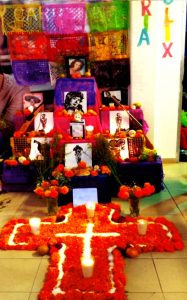
That is why an altar with offerings is placed to receive them which consists of: the 4 elements represented (air, fire, earth and water) using candles, copal, ashes etc., the food of your choice, salt, the photo or image of the person to whom the altar is dedicated, and the decoration with confetti and seasonal flowers.
In Mexico it is the cempasúchil and some article of his preference or that was in his possession, the traditional bread of the dead or the sugar skulls, the pumpkin seed candy or the pumpkin in Tacha.
A religious image is also placed of a saint or a cross and there are regions in which the altars have 7 levels.
Each level represents the states of the souls and a path of seeds or flowers so that they do not lose their way.
On the other hand, as part of the celebration, a visit is made to the pantheon or cemetery to bring flowers, music, liquor and food to the tombs of the deceased.
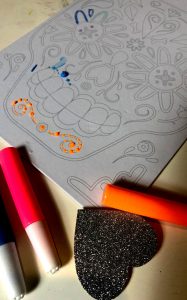
It is possible to attend the religious service offered there, and there are regions in which you can spend the night awake right there in order to receive the beings that are no longer among us and live with them that day.
I think this celebration has been an opportunity to get closer to a part of Mexican culture.
It does not matter what religion you profess or the region in which you live or the language you speak.
We all die, we all have a loved one, family member or no, that he has passed away, and we are given the opportunity to remember.
We do not necessarily have to mention their name, we all have that opportunity to have a type of closeness with who has died.
Its celebration has been a pretext to exploit creativity and give rise to films, videos, songs, fashion and books, throughout the world.
An opportunity and a reminder
The Day of the Dead is also an opportunity to live with the family, our neighbours, friends or partner, do an activity together, even if it is simply to talk about an anecdote that we live, that we read about this person or with her. Pay tribute to him by cooking his favorite dish or listening to his favorite music. Living together by candlelight having a sip of Tequila.
The day of the dead is a reminder, not only do we remember that one day we are going to die, we do not forget who we come from, what souls are part of us, who we want to remember and receive in our homes.
They are those authors of the books that are on the shelf, they are the scientists who described the laws that govern us or the artists who give color to our Museums. Since the dead to whom we dedicate the offering were not necessarily part of our family, they may be famous people or people we admire, such as: writers, philosophers, actors, politicians, etc.
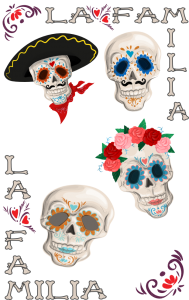
The dead regulate the relationships of individuals, we are a part of a social system and we use the codes that express the meaning of living and transcending in our group. What do we give meaning to? Who do we give a voice to? Who do we remember?
There are cultures in which talking about death sounds gloomy or is a bad omen, is very sad or is a not very precious state.
Death in Spanish is feminine, in German masculine, beyond gender, death is a phenomenon that forms part of our traditions and narratives, there are dedicated cults around it.
The festivities dedicated around the Day of the Dead give us the guideline for many Mexican migrants to get closer to the land where we were born, to the family that saw us leave. This tradition offers one day a year the possibility of having close to those who no longer live among us. And yes, how would Colombian musicians say, remembering is living.


